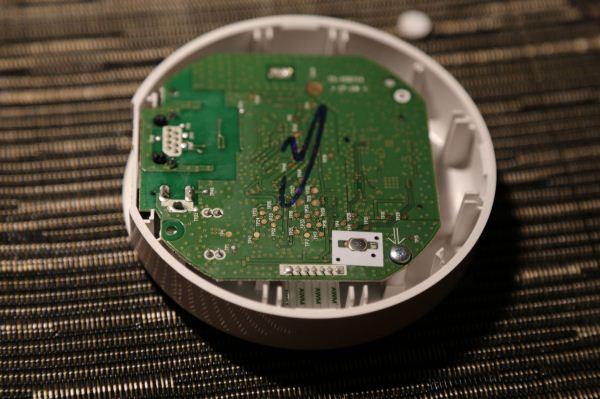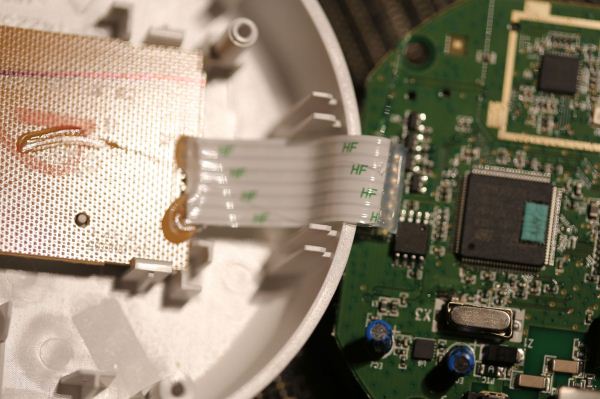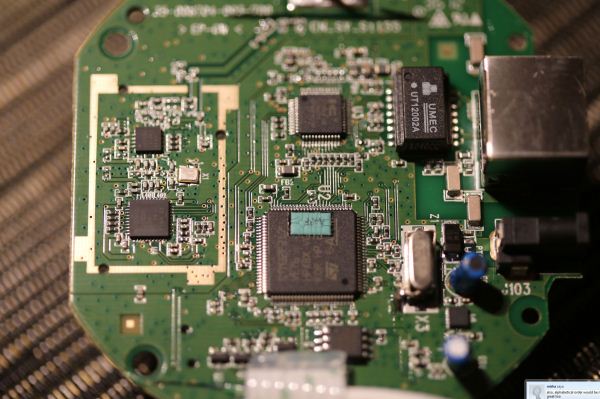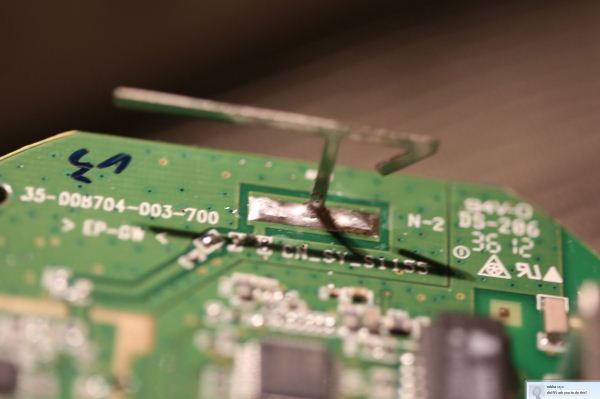Philips Hue: Automated Home Lighting Gets Colorful
by Ashu Joshi on March 1, 2013 12:50 AM EST- Posted in
- Gadgets
- Home Automation
- Philips
- Hue
- Lighting
Teardown and Design
The Hue Bridge has two screws that you need to remove before you can pop off the back. Even with the screws out, popping the back off is tricky—it has an interesting snap-in mechanism. Here’s what the back looks look like; the two white “feet” at the bottom are covering the screws. I used tools from iFixIt to get this open.
Once you open it up, you can see the back side of the PCB, and the snap-in connecter I mentioned earlier.
The PCB is connected to the front of the Bridge using a ribbon connector. This cable provides the power and signals for the LEDs and the Link button.
The main PCB has the two primary components of the Hue Bridge, an ST Microelectronics STM32F217VE Microcontrollerand a Texas Instruments CC2530 ZigBee Controller.
There is also an RF range extender (CC2590) coupled to the CC2530. The STM MCU has an integrated Ethernet controller, but as a whole the design has very few components. It’s clear that the majority of the cost for the Starter Pack is in the bulbs and not in the Bridge. (Based on the total kit price, the Bridge is $20 more than the cost of the three bulbs, though of course that leaves plenty of room for profit margins.) The image below shows the antenna for ZigBee:
I’ll cover the technology behind the Hue Bridge in a moment, but the choice of microcontroller for this design is a clear indication that this is primarily a purpose-built device. That is, it does not have the horsepower to extend to different types of applications due to the limitations of the CPU and the amount of memory. Nonetheless, it is well suited for the function at hand; let’s look at the specifics of the technology behind Hue before we get into a discussion of what it can and cannot do.





















94 Comments
View All Comments
Franks8519 - Saturday, March 16, 2013 - link
A practical question. Has anyone used these in a 6" ceiling can? It looks like they might be too small to be effective. I love the concept, but do they get lost in a 6" can?BravoRomeo - Sunday, April 7, 2013 - link
You could use the Hue bulbs in a 6" can, but they would have about the same soft/diffuse lighting effect as installing a bare 50W frosted incandescent or a 12W CFL spiral. Adding a parabolic reflector trim would help direct light downward, as without such, much light is wasted into the can and would be disappointing.A better solution, if you don't need the color changing, is the Cree CR6 LED retrofits, which are available at Home Depot for $25 to $35 (as well is a smaller 4" retrofit). Excellent color rendering with Cree's "TrueWhile" led array, dim ability, and they look great since you get a new trim as well. Cleverly, the included white trim is part of the heat sink for the LEDs. I installed two in my bathroom and am very pleased. It would be nice if Philips brings the Hue technology to a similar format.
Philips have said they are working on other bulb formats for Hue, including the venerable BR30 commonly used in 6" recessed can lights. If they can get them as bright as the Cree solution, I might be interested. I'd also like to see some emphasis on more directional lighting, which in both track and recessed applications adds much visual drama to interior lighting design. I love those Halo recessed fixtures with the hidden aimable MR16 bulb... $200 per fixture, but great for illuminating artwork without drawing attention to themselves.
Sascha Schweitzer - Wednesday, April 10, 2013 - link
With the Hue Alarm Clock app you can now set wake-up timers on Android. Really missed that feature in the Philips app...calvin@123 - Thursday, March 30, 2017 - link
Smart Electronics and Smart RGBW LED Controller with dimmer brings colorful led and wide range implementations give you the power to control LEDs with Bluetooth and Micro Controller firmware software buildCheckout our link : http://www.pupaclic.com/iot/smart-rgbw-led-control...